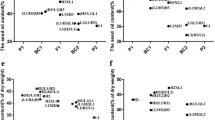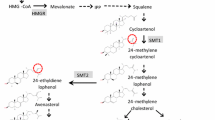Abstract
High oil content is one of the most important characteristics of rapeseed (Brassica napus L.) breeding. In order to understand the genetic basis of seed oil content, a series of reciprocal crosses between rapeseed parents with high oil content (53110, 61616 and 6F313), medium-oil content (Zhongshuang 9) and low oil content (51070 and 93275) were conducted. It was found that the oil content of F1 hybrid seeds in rapeseed was mainly controlled by the maternal genotype. The maternal effect value of oil content was estimated to be 0.86. The pollen parent had a xenia effect on oil content, estimated to be 0.14 which changed the mean value by 1.86 percent. The inheritance of oil content was studied in a set of 8 × 8 diallel crosses of different varieties. The results indicated that the inheritance of oil content could be explained by an additive-dominant-epistasis model. Although the dominant and additive effects played major roles and accounted for more than 70% of the total variance, there was also a small epistatic effect. The broad and narrow sense heritability of oil content was 83.88 and 36.94%, respectively. Based on the oil content differences between the reciprocal crosses in the same offspring generation (F1 and F2) in rapeseed, it could be concluded that there were significant cytoplasmic effects on oil content. In this study, two lines with significantly cytoplasmic effects, either positive or negative, were selected.

Similar content being viewed by others

References
Chen JL, Beversdorf WD (1990) Fatty acid inheritance in microspore-derived populations of spring rapeseed (Brassica napus L.). Theor Appl Genet 80:465–469
Cong ZJ (1996) Study on the effect of maize kernel oil genes at the F1 embryo stage and its application. MS Dissertation of China Agricultural University P7
Delourme R, Falentin C, Huteau V, Clouet V, Horvais R, Gandon B, Specel S, Hanneton L, Dheu JE, Deschamps M, Margale E, Vincout P, Renard M (2006) Genetic control of oil content in oilseed rape (Brassica napus L.). Theor Apple Genet 113:1331–1345
Duan MX, Song TM, Wang LM, Fan HW, Zhao JR (2002) Study on the xenia effect of high oil corn. Acta Agron Sin 28:208–214
Engqvist GM, Becker HC (1991) Relative important of genetic parameters for selecting between oilseed rape crosses. Hereditas 115:25–30
Gan GX, Lin SC (1997) Research on and breeding for high oil content in rapes. Seed 1:31–33
Jonsson R (1977) Erucic acid heredity in rapeseed (Brassica napus L. and Brassica campestris L.). Hereditas 86:159–170
Kondra IP, Stefasom BR (1970) Inheritance of the major glucosinolates of rapeseed (Brassica napus L.). Can J Plant Sci 50:643–647
Letchworth MB, Lambert RJ (1998) Pollen parent effects on oil, protein, and starch concentration in maize kernels. Crop Sci 38:363–367
Mahmood T, Rahman MH, Stringam GR, Yeh F, Good AG (2006) Identification of quantitative trait loci (QTL) for oil and protein contents and their relationships with other seed quality traits in Brassica juncea. Theor Appl Genet 113:1211–1220
Mou TM, Liu HL (1990) Genetic analysis on the total content of glucosinolates in seeds of rape (Brassica napus L.). Acta Agron Sin 16:97–105
Pai R, Kumar P (1991) Estimates of gene effects of oil content under normal and late sowing in mustard (Brassica Juncea). India J Agron Sci 61:918–921
Pixley KV, Bjarnason MS (1994) Pollen-parent effects on protein quality and endosperm modification of quality protein maize. Crop Sci 34:404–409
Qi CK, Gai JY, Zhang YM (2001) Major gene plus polygene inheritance of erucic acid content in Brassica napus L. Acta Genet Sin 28:182–187
Shen JX, Fu TD, Yang GS, Ma CZ, Tu JX (2005) Genetic analysis of rapeseed self-incompatibility lines reveals significant heterosis of different patterns for yield and oil content traits. Plant Breed 124:111–116
Si P, Mailer RJ, Galwey N, Turner DW (2003) Influence of genotype and environment on oil and protein concentration of Canola (Brassica napus L.) grow across southern Australia. Aust J Agric Res 54:397–407
Song TM, Wu HP, Dai SH, Wu XQ (1991) Genetic effects of corn kernel oil controlling genes in reciprocal crosses. Acta Agric Univ Pekin 17:15–22
Wang HZ (2004) Strategy for rapeseed genetic improvement in China in the coming fifteen years. Chin J Oil Crop Sci 26:98–101
Wang HZ (2005) The potential problems and strategy for the development of biodiesel using oilseed rape. Chin J Oil Crop Sci 27:74–76
Wu JG, Shi CH, Zhang HZ, Fan LJ (2002) Study on analysis of oil content of intact rapeseed with few sample size by near infrared reflectance spectroscopy. Acta Agron Sin 18:421–425
Wu JG, Shi CH, Zhang HZ (2006a) Study on developing calibration models of fat acid composition in intact rapeseed by near infrared reflectance spectroscopy. Spectrosc Spectr Anal 26:259–262
Wu JG, Shi CH, Zhang HZ (2006b) Partitioning genetic effects due to embryo, cytoplasm and maternal parent for oil content in oilseed rape (Brassica napus L.). Genet Mol Biol 29:533–538
Zhang HZ, Shi CH, Wu JG, Ren YL, Li CT (2004) Genetic analysis of embryo, cytoplasm and maternal plant effects for glucosinolate content in rapeseed. Acta Agron Sin 30:31–35
Zhao JY, Becker HC, Zhang DQ, Zhang YF, Ecke W (2005) Oil content in a European × Chinese rapeseed population: QTL with additive and epistatic effects and their genotype-environment interactions. Crop Sci 45:51–59
Zhao JY, Becker HC, Zhang DQ, Zhang YF, Ecke W (2006) Conditional QTL mapping of oil content in rapeseed with respect to protein content and traits related to plant development and grain yield. Theor Appl Genet 113:33–38
Zhu J (1996) Analytic methods for seed models with genotype × environment interactions. Acta Genet Sin 23:56–68
Zhu J, Weir BS (1994) Analysis of cytoplasmic and maternal effects I. A genetic model for diploid plant seeds and animals. Theor Appl Genet 89:153–159
Zhu J, Weir BS (1996) Diallel analysis for sex-liked and maternal effects. Theor Appl Genet 92:1–9
Acknowledgment
This project was supported by National Key Basic Research Program (2006CB101607) and National High Technology Research and Development Program of China (2007AA100106).
Author information
Authors and Affiliations
Corresponding author
Rights and permissions
About this article
Cite this article
Wang, X., Liu, G., Yang, Q. et al. Genetic analysis on oil content in rapeseed (Brassica napus L.). Euphytica 173, 17–24 (2010). https://doi.org/10.1007/s10681-009-0062-x
Received:
Accepted:
Published:
Issue Date:
DOI: https://doi.org/10.1007/s10681-009-0062-x



